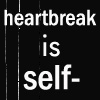Non sequitur is Latin for "it does not follow," and is usually interpreted in a way that would make its meaning closer to "it does not fit." I feel that this phrase adequately describes some portions of the book, as well as its ending.
After finishing Blankets, I feel that there was a lack of closure in its ending. There are so many things left hanging, such as his relationship with Raina, his religious issues with his parents, his career, etc. The last Christmas scene at his house is very unfulfilling and I feel that it does not reveal enough of the story; it seems like a superfluous scene to me. However, overall I think that I liked the book due to the story, the great visuals, and surprisingly, the empathability (yay for making up words) of the characters.

Craig, for me, was a frustrating character. I seemed to like him less and less as he grew older, though I still sympathized with him and wanted him to be successful in his endeavors. As a child, in his interactions with his brother, he's certainly not nice to his sibling all of the time but he is likable simply because he seems to have a childish innocence and joy in life. Of course, he starts to develop personality traits that are visible in his teen years, including a painful sense of self-consciousness and neuroticism (see panel on pg. 450 contrasting his reaction and his brother's to the "surprise"). In his teen years, I get the sense that he is simply lost--and desperately trying to cling to anything that will anchor him to reality. You could say that he is emo, as his haircut perhaps indicates. As a result, there is an increasing sense of self-absorption in his narrative that becomes particularly frustrating when it comes to his treatment of Raina. His hanging up on her and his subsequent isolation from her indicates his weakness and inability to take responsibility and handle a long term relationship; no, not even--his inability to be there for one that he supposedly loves.

The adult Craig is no better. He seems to have developed an attitude of nonchalance in the city. Although he displays increasing attitudes of secularism, he does not have the strength to tie up loose ends at home. The city is merely another place for him to escape too without facing up to his past and the memories that keep bubbling up.
In particular, the final scene of Craig walking in the snow and contemplating (with a motif of jumping across snow) the satisfaction of him leaving an impact in the world is unsatisfactory for me. Where does his sense of satisfaction come from? From leaving everything behind? I think he puts too much emphasis on the mere fact that he left footprints in the snow, without judging the quality of those footprints, to continue his analogy.

Another scene that felt discordant was on pgs. 504-505, which showed another example of supposed-to-be-poetic descriptions of the melting scenery that I think would have been better without the redundant text. However, the following panels include two more notable things that don't fit, including a panel with melting snow on pg. 508 in which the water is melting from the white space surrounding the panels. It looks extremely peculiar and even reminds me of dripping blood (maybe I've watched too much Sin City). Another peculiarity is the dictionary definition of thaw on pg. 510, which includes "to become less reserved." If the thawing of nature is supposed to correlate with the thawing of Craig's personality, I don't think the analogy works because I think he becomes more reserved, not less.
The most glaring non sequitur sequence to me, however, was the inclusion of the allegory of the cave. I feel that it was juxtaposed very poorly with scenes of Craig's life and the development of the ending of his relationship with Raina. The point of Socrates telling Glaucon about the cave was to make him realize the boundaries of human knowledge, to knock down our hubris a bit, to show us how much more there is still to learn (at least, that's what I remember from reading the Republic last year in AP English, but I'll have to reread the passage to make sure). Craig hangs up on Raina right after he finishes describing the ultimate achievement the imprisoned humans are supposed to have accomplished--looking directly into the sun (pg. 503). The humans are supposed to be enlightened. Craig hanging up on Raina because he is "enlightened" to her true feelings for him is a complete perversion of the analogy.









